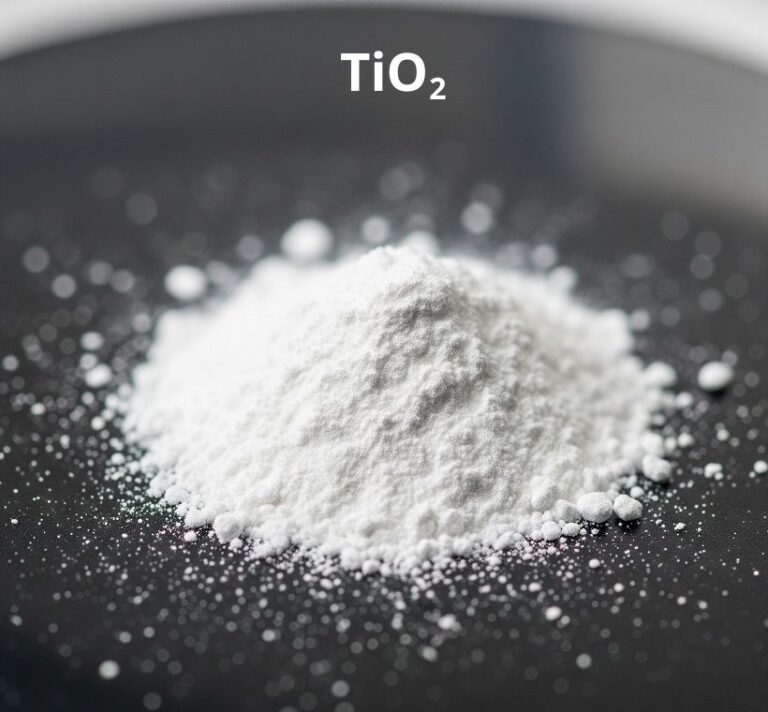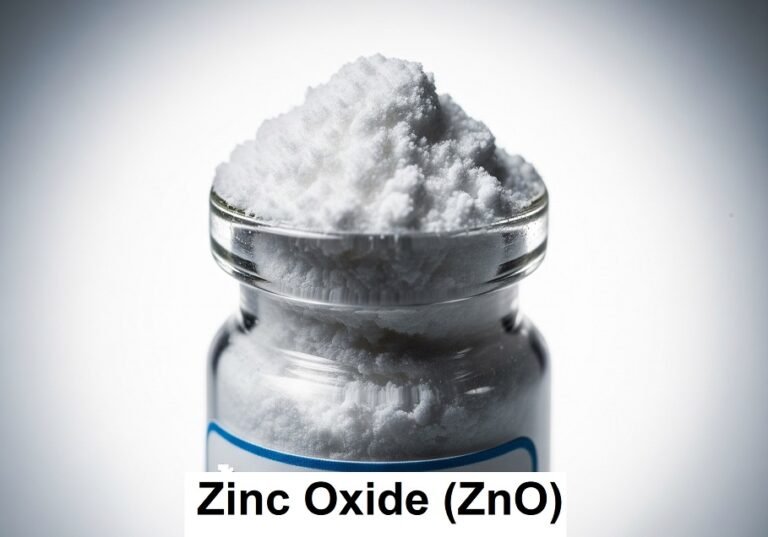
Boric acid is a hydrate of boron trioxide, existing as both the trihydrate orthoboric acid, H3BO3 (B2O3·3 H2O), and the monohydrate metaboric acid, HBO2 (B2O3·H2O). Orthoboric acid is the commonly encountered commercial form, often simply referred to as boric acid.
Boric acid also occurs naturally as the mineral sassolite. The structurally descriptive formula for boric acid is B(OH)3, and the IUPAC systematic name is trihydoxidoboron. The terms “pyroboric acid” and “tetraboric acid” are found in older literature but do not represent well-defined solid-phase compounds.
Table of Contents
1. Physical Properties of Boric Acid
Boric acid crystals form as odorless, white platelets from an aqueous solution. The prevailing crystalline structure of orthoboric acid, which has a melting point of 170.9 °C when heated in an enclosed space, is triclinic, characterized by a sheet-like arrangement.
These sheets contain coplanar B(OH)3 molecules linked together by hydrogen bonds. Weak van der Waals forces hold stacks of B(OH)3 sheets together, allowing easy splitting of crystals into slippery flakes, a property that contributes to boric acid’s lubricating qualities.
Metaboric acid exists in three crystalline forms. Dehydrating orthoboric acid at 100–130 °C produces flaky crystals of orthorhombic HBO2 (III) (density 1.784 g/cm³, melting point 176 °C). Following the removal of remaining B(OH)3 at temperatures up to 160 °C, a coarsely crystalline monoclinic HBO2 (II) (β-form, density 2.044 g/cm³, melting point 201 °C) remains.
At higher temperatures (200–250 °C), a viscous liquid forms, from which cubic HBO2 (I) (γ form, density 2.486 g/cm³, melting point 236 °C) gradually crystallizes. With around 1% moisture remaining, HBO2 (I) serves as a seed for the crystallization of hexagonal (α form) boron trioxide.
The structures of these metaborate forms range from containing all trigonal boron atoms in HBO2 (III) to one-third tetrahedral boron in HBO2 (II) to all tetrahedral boron in HBO2 (I).
The vapor pressure of boric acid is primarily due to water in dehydration equilibria. Below 160 °C, the vapor consists of water and boric acid molecules. At higher temperatures, HBO2 is also present in the vapor phase, and (HBO2)3 becomes a significant species above 940 °C.
In aqueous solutions, boric acid behaves as a weak acid, with a pKa of 9.23 at 25 °C. The pH of its solutions decreases with increasing concentration due to the formation of trimeric and tetrameric species. The pH also rises with temperature.
The solubility of boric acid in water is enhanced by adding salts like KCl, KNO3, RbCl, K2SO4, and Na2SO4, while LiCl, NaCl, and CaCl2 reduce solubility.
Boric acid volatilizes with steam, and the distillate from a boiling saturated solution contains approximately 0.18% boric acid. Notably, boric acid is highly volatile from concentrated solutions made acidic by strong acids, leading to losses from solution in low molecular mass alcohols due to the formation of volatile borate esters.
| T (°C) | Solubility of B(OH)3 in wt% water |
|---|---|
| 0 | 2.4 |
| 10 | 3.5 |
| 20 | 4.7 |
| 30 | 6.2 |
| 40 | 8.8 |
| 50 | 10.3 |
| 60 | 13.0 |
| 70 | 15.8 |
| 80 | 19.1 |
| 90 | 23.3 |
| 100 | 27.5 |
| Concentration of boric acid wt% | pH Values at 20 °C |
|---|---|
| 0.1 | 6.1 |
| 0.5 | 5.6 |
| 1.0 | 5.1 |
| 2.0 | 4.5 |
| 4.0 | 3.9 |
| Solvent | T (°C) | Solubility of B(OH)3 (g/100 g solvent) |
|---|---|---|
| Methanol | 20 | 20.68 |
| Ethanol | 25 | 94.4 |
| n-Butanol | 25 | 42.8 |
| n-Propanol | 25 | 59.4 |
| 2-Methylbutanol | 25 | 35.3 |
| Isoamyl alcohol (3-methyl-1-butanol) | 25 | 2.39 |
| Ethylene glycol | 25 | 18.5 |
| Propylene glycol | 25 | 15.06 |
| Diethylene glycol | 25 | 13.6 |
| Glycerol (86.5 %) | 20 | 21.1 |
| Glycerol (98.5 %) | 20 | 19.9 |
| Glycerol | 25 | 17.55 |
| Mannitol (10 %) | 25 | 6.62 |
| Acetone | 25 | 0.6 |
| Methyl ethyl ketone | 20 | 0.7 |
| Methyl butyl ketone | 20 | 0.23 |
| Ethyl acetate | 25 | 1.5 |
| Acetic acid (glacial) | 30 | 6.3 |
| Diethyl ether | 20 | 0.008 |
| Dioxane | 25 | 15 |
| Aniline | 20 | 0.15 |
| Pyridine | 25 | 70 |
| Ammonia (liquid) | 25 | 1.88 |
| Fuel oil | 25 | 2.46 |
2. Chemical Properties of Boric Acid
A Weak Acid
Distinguished by its weak acid nature, boric acid has a pKa value of 9.24 at 25°C. This property dictates its behavior in aqueous solutions, where it partially dissociates into protons (H+) and borate ions (B(OH)4–).
This dissociation, though limited, contributes to boric acid’s antiseptic and antifungal properties.
Boric acid readily reacts with strong bases, leading to the formation of metaborate ions, B(OH)4–, which act as conjugate bases. Its reactions with alcohols result in the production of borate esters, showcasing its affinity for hydroxy compounds.
Reactions with Fluoride Ions and Diols
In the presence of fluoride ions, boric acid undergoes a transformation, giving rise to tetrafluoroboric acid.
Interactions between boric acid and diols, particularly those containing 1,2- or 1,3-diol functionalities, play an important role in borate chemistry. These diols can form stable five- and six-membered cyclic esters with boric acid, demonstrating its tendency to complex with specific organic molecules.
Applications in Analytical Chemistry and Beyond
Boric acid is a relatively weak acid which poses challenges for accurate titration, a common technique in analytical chemistry. To overcome this limitation, the addition of polyol complexing agents, such as mannitol or sorbitol, to aqueous boric acid solutions significantly enhances its acidity. This modification enables precise titration using colorimetric indicators, expanding the range of analytical applications for boric acid.
The cross-linking ability of boric acid with two equivalents of diols to form spiro-diesters finds applications in various fields. For instance, environmental boron plays a critical role in cross-linking the complex carbohydrate rhamnogalacturonan II in plant cell walls, an essential process for plant growth.
Reaction with diol compounds
Interactions between boron and diol-bearing substrates are important in marine organisms, suggesting that similar diol reactions may have significant metabolic functions in both plants and animals.
Borate cross-linking of carbohydrates finds application in various commercial uses, including starch adhesives, rheological fluids for oil-field applications, and poly(vinyl alcohol) cross-linked by boric acid for polarizing films in electronic display panels.
3. Production of Boric Acid
Boric acid production relies on borate minerals and brines as primary raw materials. Borates, including borax, kernite, colemanite, ascharite, ulexite, and hydroboracite, react with strong mineral acids to form boric acid.
Sodium borate minerals are the main source for boric acid production in the United States, while Turkey uses colemanite extensively. Borates extracted from the saline brine of Searles Lake in California are processed into boric acid.
Russia produces boric acid from the borosilicate mineral datolite; occasionally, refined borax penta- or decahydrate serves as the starting material.
The large-scale boric acid plant operated by U.S. Borax Inc. in Boron, California, leaches crushed kernite ore (Na2B4O7·4 H2O) with sulfuric acid in hot recycled weak liquor.
Coarse gangue is separated, and fine particles are settled to produce concentrated boric acid strong liquor, saturated with sodium sulfate. Careful pH and temperature control ensures complete sodium sulfate solubility.
The strong liquor undergoes filtration, followed by two-stage boric acid crystallization in continuous crystallizers. The temperature is then lowered to precipitate boric acid crystals. These crystals are filtered, washed, dried in rotary dryers, screened, and prepared for shipment.
Datolite, a common borosilicate mineral with the formula CaB(SiO4)(OH) or 2 CaO·B2O3·2 SiO2·H2O, is a raw material for producing boric acid. In Dalnegorsk, Russia, datolite ore is finely ground and digested with sulfuric acid. The resulting solution, after silica coagulation upon heating, is separated then boric acid is crystallized.
At Searles Lake, California, borax is present in brine at a concentration of approximately 1.5% (expressed as anhydrous borax) along with various salts. A liquid-liquid extraction method selectively separates borate from brine.
Borate is extracted into a water-insoluble solvent, such as kerosene, using an aromatic polyol that efficiently complexes the borate ion.
The organic phase is isolated and acidified with sulfuric acid, yielding an aqueous solution containing boric acid and sodium sulfate. The liquor is concentrated by evaporation then cooled to induce boric acid crystallization.
4. Uses of Boric Acid
Borates, including boric acid, are key ingredients in various industrial fluids such as automotive antifreeze/coolants, brake fluids, lubricating oils, greases, metalworking fluids, and hydraulic fluids. They contribute to improved lubrication, wear reduction, buffering, corrosion inhibition, water scavenging, and thermal stability.
Boric acid is used in commercial adhesives, particularly in starch and dextrin adhesives. These adhesives are applied in the manufacture of paper and paperboard products, including corrugated boxes, cartons, tubes, and grocery bags. Boric acid serves as a cross-linking agent, enhancing viscosity, tackiness, and fluid properties.
Boric acid finds applications in oil and gas recovery. It is utilized in producing rheological fluids for oil-field applications, contributing to hydraulic fracturing operations and delaying the setting rate of Portland cements used in construction applications for oil and gas wells.
Boric acid in alkaline solutions is employed for corrosion inhibition in water treatment systems, including recirculating water systems, steam boilers, heat exchangers, and heating/cooling systems. It prevents corrosion by anodic passivation and buffering mechanisms.
Boric acid is an essential nutrient for plants, and its supplementation to deficient soils is a common agricultural practice. Boric acid is applied to various crops, including oil palm, peanuts, apples, grapes, olives, alfalfa, cotton, canola, sugar beets, and other fruit and vegetable crops, to improve crop quality and yields.
Boric acid is used in pest control, especially in the control of specific insect species, including termites, cockroaches, carpenter ants, and wood-destroying beetles. It is applied as a concentrated aqueous solution in the remedial treatment of termite infestations in residential dwellings.
Borates, including boric acid, have a long history of use in cleaning and laundering applications and as ingredients in personal-care products. They contribute to buffering, suspension, anti-reposition of soil and stain particles, water softening, viscosity control, emulsification, foam stabilization, odor control, and corrosion inhibition.
Boric acid is widely used in fire-retardant applications. It is effective in reducing the flammability of cellulosic materials, such as wood products, cellulose insulation, and cotton batting. Boric acid is added to various materials, including polymers, to enhance fire resistance.
Borates and boric acid have multiple uses in metallurgy, including smelting operations for the recovery of precious and nonferrous metals, wire drawing, boriding, brazing, welding, soldering, and the manufacture of alloys.
Boric acid is used in pressurized-water reactors in the nuclear industry. Differing concentrations of boric acid in the primary coolant are used to control the steady state of the reactor along with control rods. Boric acid and other borates are also used in emergency reactor shutdown systems.
Particularly, boric acid finds use in the Kraft pulping industry, employing a process known as partial borate autocausticizing (PBAC).
5. Toxicology of Boric Acid
- Boric acid has low acute toxicity.
- Boric acid is not a skin irritant or skin sensitizer.
- Boric acid is not carcinogenic or mutagenic.
- Boric acid may cause developmental effects in rats, mice, and rabbits.
- Boric acid may have adverse effects on male reproduction in laboratory animals, but there is no clear evidence of male reproductive effects in humans attributable to boron.
- Occupational exposure limits of boric acid is 2 mg/m³.
Reference
- Boric Oxide, Boric Acid, and Borates; Ullmann’s Encyclopedia of Industrial Chemistry. – https://onlinelibrary.wiley.com/doi/abs/10.1002/14356007.a04_263.pub2



